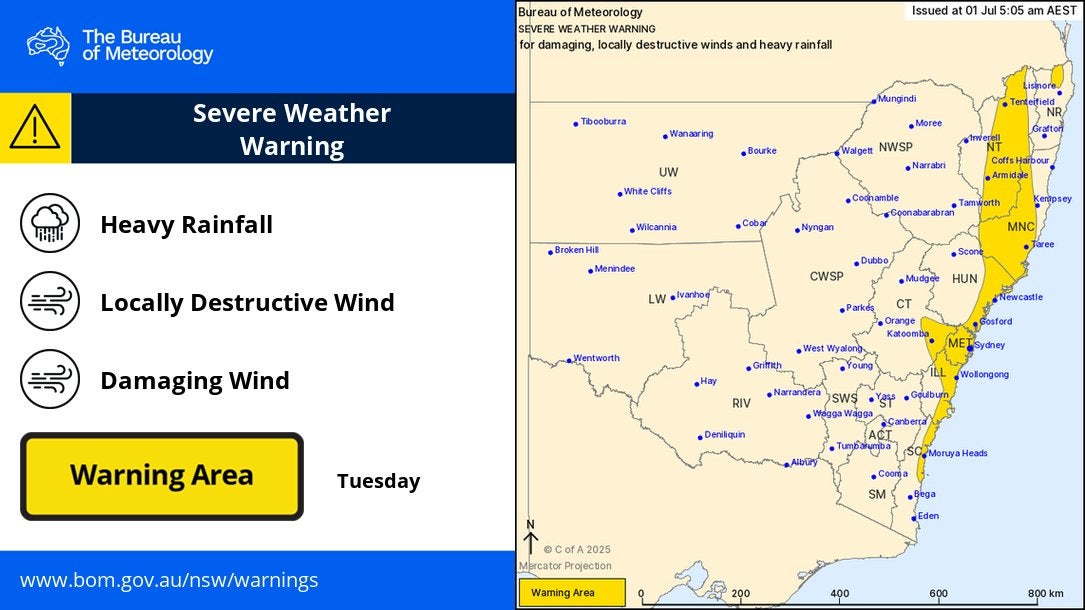
A rapidly intensifying low-pressure system known as a “bomb cyclone” is lashing Australia’s eastern coast with torrential rain and winds of up to 110 kmph, raising fears of flash floods, coastal erosion and major transport disruptions.
Millions of people from Coffs Harbour to Bega are in the path of the storm, which is expected to dump over 100 mm of rain in just hours, including up to 200 mm on the central coast.
Greater Sydney alone is likely to see 120 mm rain over a six-hour period, according to the Bureau of Meteorology.
Intense winds and rainfall were already hitting areas from the Mid North Coast to Bega, including Sydney and the Illawarra region, on Tuesday. People in most of coastal Sydney were advised to stay indoors as dangerous winds hit the city, including gusts in excess of 125kmph. And state authorities warned the worst was yet to come.
“It may seem pretty bad but the terrible thing is the situation is going to worsen over the course of the next 24 hours, particularly later this afternoon and into the evening tomorrow,” NSW emergency services minister Jihad Dib noted.
“We are asking people to be as prepared as they possibly can be. That system stretches as far from the Mid North Coast down to potentially Bega on the South Coast. Just the sheer size of it is quite enormous.”
NSW State Emergency Service operations manager Dallas Burnes said: “We’re already starting to see the impacts – 600 incidents responded to in the last 24 hours and over a thousand of our volunteers out helping their communities already.”
A vigorous coastal #LowPressureSystem will develop near the #NewSouthWales coast today, before rapidly intensifying tomorrow. #SevereWeatherWarnings are current for parts of #NSW.
— Bureau of Meteorology, Australia (@BOM_au) June 30, 2025
Latest warnings: https://t.co/6aWuXcq00P pic.twitter.com/dlXWQCYiIX
He warned: “We are really concerned about flash flooding, particularly around the commute home for people this afternoon, as we see those rainfall figures escalate throughout the day.”
The bureau said the storm’s peak impact was forecast for Wednesday, with a risk of flash flooding in areas such as Wallis Lake near Taree, which was hit hard by deadly floods in May.
Weather warnings cover a wide swathe of New South Wales, including Newcastle, Gosford, Sydney, Wollongong, and Port Macquarie, where saturated soils from previous floods raise the risk of trees toppling in gusts forecast up to 125 kmph.

A bomb cyclone is a storm system that undergoes "bombogenesis", a term used by meteorologists when a large storm rapidly strengthens over a 24-hour period, according to forecaster AccuWeather. While the vast majority of such storms occur over the ocean, the storm can be both tropical and non-tropical.
Meteorologist Milton Speer warned this storm’s rapid deepening could steer it closer to heavily populated areas. “When the surface low is more fully developed east of the coast overnight or tomorrow morning under the upper trough, dumb-belling of the surface low is likely to send it closer to the Central and Hunter coasts, returning rain and strong winds to those areas.”
He added that research showed the climate crisis had pushed east coast lows to form further south and further offshore than in the past.
Experts say that unusually warm ocean temperatures off Australia’s east coast are fuelling the storm’s intensity by adding moisture to the atmosphere.
“It seems safe to say that the current very high water temperatures off the eastern Australian coast would help such systems to become intense,” Dr Martin Jucker, senior research fellow in the climate change research centre at the University of New South Wales, said.
Conditions are expected to ease by Thursday, but officials are urging residents to be prepared.
This new biodegradable film could save 20 per cent on annual energy bills
Sleep apnoea cases may double this century due to global warming, researchers warn
Delhi to attempt artificial rain to tackle toxic air
More than 100 people temporarily stranded after fleeing 478-acre California blaze
More Mediterranean and drought planting features in garden show as heatwave hits
Firefighters urge Government to tax polluters to fund struggling services







